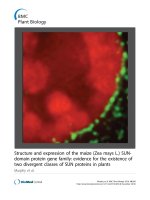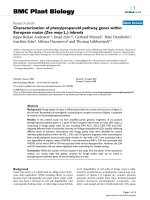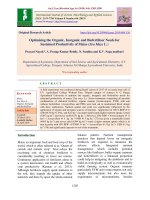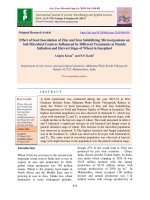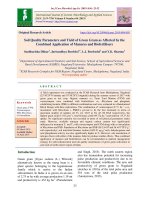Physical and chemical properties of sandy soil as influenced by the application of hydrogel and mulching in maize (Zea mays L.)
Bạn đang xem bản rút gọn của tài liệu. Xem và tải ngay bản đầy đủ của tài liệu tại đây (184.02 KB, 7 trang )
Int.J.Curr.Microbiol.App.Sci (2018) 7(7): 3612-3618
International Journal of Current Microbiology and Applied Sciences
ISSN: 2319-7706 Volume 7 Number 07 (2018)
Journal homepage:
Original Research Article
/>
Physical and Chemical Properties of Sandy Soil as Influenced by the
Application of Hydrogel and Mulching in Maize (Zea mays L.)
R. Shiva Kumar*, T.K. Bridgit and A. Chanchala
Department of Agronomy, College of Agriculture, Padannakkad, Kerala Agricultural
University, Thrissur, Kerala, India
*Corresponding author
ABSTRACT
Keywords
Hydrogel, Rice
straw mulch, Rice
husk mulch,
Coirpith compost
mulch, Porosity,
Bulk density and
Available soil N,
P2O5 and K2O
Article Info
Accepted:
26 June 2018
Available Online:
10 July 2018
A field experiment was conducted at College of Agriculture, Padannakkad, Kerala
Agricultural University, Thrissur, Kerala, India to study the effect of hydrogel (super
absorbent polymer) and mulching on physical and chemical properties of sandy soil in
maize (Zea mays L.). The experiment was conducted in factorial randomized block design
having two factors with three levels each and one additional control. Different levels of
hydrogel and types of mulches, their interactions and a control were analysed statistically
on physical properties of soil like porosity and bulk density and chemical properties like
available soil N, P2O5 and K2O. Results revealed that main effects of hydrogel applied @
3.75 kg ha-1 and coirpith compost mulch @ 2.5 t ha-1 recorded the maximum soil porosity.
The residual nutrient status with respect to available soil N and K 2O recorded maximum
with main and interaction effects of treatments contain hydrogel @ 1.25 kg ha -1 and rice
husk mulch @ 5 t ha-1 and available soil P2O5 was recoded maximum with hydrogel @
3.75 kg ha-1 and rice husk mulch @ 5 t ha-1. Control recorded the high available soil N,
P2O5, K2O content than the remaining treatments.
Introduction
Maize (Zea mays L) is one of the most
versatile crop having capacity to adapt under
different agro-climatic conditions (Kogbe and
Adediran, 2003), with altitudinal ranges of 0
to 3000 meters above the mean sea level.
Generally, maize is known as “queen of
cereals” because it has the highest genetic
yield potential among the cereals. In India,
maize is the third most important food crop
after rice and wheat. In addition to staple food
for human being and quality feed for animals,
maize serves as a basic raw material for
thousands of industrial products like starch,
oil, protein, alcoholic beverages, food
sweeteners, pharmaceuticals, cosmetics, film,
textile, gum, package and paper industries etc.
According to Wallace (2000), presently 80 per
cent of water resources are available in the
world for supporting irrigated agriculture. As
resources of water decreases, water saving
agriculture is required for the sustainable
growth of human societies. Besides, due to
3612
Int.J.Curr.Microbiol.App.Sci (2018) 7(7): 3612-3618
climate changes droughts are predicted to
increase. So it is the need of the hour to adopt
different practices to improve the crop
production under water scares condition
(Gornall et al., 2010). In present experiment a
new technology which is hydrogel and an old
technology which is mulching with different
organic mulches were used for conservation of
moisture in the soil.
Less moisture retaining capability, less
fertility and high percolation losses of soil
moisture caused the less crop productivity in
sandy soils and finally reduced moisture and
nutrient use efficiency (Rigas et al., 1999;
Sivapalan, 2006). Hydrogel absorbs 20 times
more water than its own weight. Because of
the improvement of a more cross-linked
polymer having more water holding capacity
(400 to 2000 times than its weight) and its less
cost has revived interest on the utilization of
hydrogel in Agriculture. Several studies have
been focused on the efficacy of hydrogel uses
in sandy soils and in soils of desert areas.
Hydrogel prolongs the plant nutrient and water
uptake by releasing the water slowly over a
longer period. It decreases the water usage and
improves the physical properties of the soil.
Moreover, this may be providing accurate
entry to essential nutrients for plant growth
and thus the biomass production was
noticeably improved (Gunes et al., 2016).
Hydrogel improved the physical condition of
soils like porosity, bulk density, water holding
capacity, soil permeability, infiltration rate,
etc. Improvement of porosity causes the
enhancement in seed germination, seedling
emergence rate, root growth. It also improved
biological/microbial activities in the soil, that
enhanced the air accessibility in root zone of
plants (Dar et al., 2017).
According to Mbagwu (1989), organic wastes
application decreases soil apparent specific
gravity and enhances total porosity of soil.
Crop residue mulch application @ 4 and 6 t
ha-1 improved chemical and physical
properties of the soil and finally increased
grain yield of the crop (Bhatt et al., 2004;
Khurshid et al., 2006). Mulching offers an
improved soil environment, controls soil
temperature, enhances soil porosity and water
infiltration rate at severe rain and maintains
runoff and erosion besides it supress weeds
development (Anikwe et al., 2007; Glab and
Kulig, 2008). Besides preserving water and
preventing erosion, mulching also enhanced
the soil flora and fauna, supress weeds growth
and maintains maximum crop productivity
(Essien et al., 2009). The other findings
proved that rice husk upgraded soil physical
properties and which improves the corn grain
yield. Porosity significantly changes moisture
circulation and air exchange in soil (Uguru et
al., 2015).
Materials and Methods
The experiment was conducted at College of
Agriculture, Padannakkad, Kerala Agricultural
University, Thrissur, Kerala, India. Soil of
experimental field is sandy. The experiment
was laid out in factorial randomized block
design having two factors with three levels
each and one additional control. Hydrogel and
mulch were the two factors. Three levels of
hydrogel H1 – 1.25 kg ha-1, H2 – 2.5 kg ha-1,
H3 – 3.75 kg ha-1 and three types of mulch M1
– rice straw mulch, M2 – rice husk mulch, M3
– Coir pith compost mulch were tested in the
study. Straw mulch and rice husk mulch was
applied @ 5 t ha-1 and coir pith compost
mulch was applied @ 2.5 t ha-1.The treatment
combinations were T1 - 1.25 kg ha-1 hydrogel
+ rice straw mulch, T2 - 1.25 kg ha-1 hydrogel
+ rice husk mulch, T3 - 1.25 kg ha-1 hydrogel +
Coir pith compostmulch, T4 - 2.5 kg ha-1
hydrogel + rice strawmulch, T5 - 2.5 kg ha-1
hydrogel + rice huskmulch, T6 - 2.5 kg ha-1
hydrogel + coir pith compostmulch, T7 - 3.75
kg ha-1 hydrogel + rice strawmulch, T8 - 3.75
3613
Int.J.Curr.Microbiol.App.Sci (2018) 7(7): 3612-3618
kg ha-1 hydrogel + rice huskmulch, T9 - 3.75
kg ha-1 hydrogel + coir pith compostmulch,
T10 - control (without hydrogel and mulch).
Before the start of experiment to all the
treatments an equal amount of FYM was
applied @ 25 t ha-1. Fertilizers were applied @
135:65:15N, P2O5, K2O kg ha-1respectively.
Nitrogen was applied in three equal doses,
first as basal, second at knee high stage and
third at tasseling stage. Full dose of P2O5 and
half dose of potassium was applied as basal
and the remaining half dose of K2O was
applied at tasseling stage along with N. The
observations were recorded at harvest stage on
soil physical properties like bulk density and
porosity and the chemical properties like
available soil N, P2O5 and K2O. The methods
adopted for estimation of physical and
chemical properties of soil are presented in the
Table 1.
The data on bulk density of soil at harvest
stage of maize crop (Table 2 and 3), indicated
that there was no significant difference among
the levels of hydrogel, types of mulches, their
interactions and between control and other
treatments.
superior to other levels of hydrogel @ 2.5 kg
ha-1 and 1.25 kg ha-1. Generally sandy soil has
less porosity than the fine textured soils
though it contains large pores. Increased
porosity of soil with increase in the hydrogel
dose might be due to occupying of large sandy
soil pores with hydrogel. Increased porosity of
soil due to hydrogel application was also
observed by Uz et al., (2008). Among the
types of mulch, maximum porosity was
observed with coirpith compost mulch @ 2.5 t
ha-1 (43.56 %) which was significantly
superior to rice straw and rice husk mulch.
The maximum porosity was observed in case
of coirpith compost mulch than other two
types of mulch might be due to fine texture of
coir pith compost and was mixed well with
sandy soil than the other two types of mulches
viz. rice straw mulch and rice husk mulch. The
microbial decomposition products of organic
mulches such as polysaccharides and bacterial
gums are known to act as soil particle binding
agents. These binding agents improve soil
aggregation and hence increase the porosity
(Bhatia and Shukla, 1982). Increase in the
porosity of soil due to mulching was observed
by Uguru et al., (2015). Porosity of soil
revealed no significant difference among the
interaction effects of levels of hydrogel and
types of mulches and when comparing the
control with rest of treatments.
Porosity
Available soil N
The data on porosity of soil at harvest of the
crop are presented in Table 2 and 3. The
results showed that porosity of soil was
significantly influenced by levels of hydrogel
and types of mulch and no significant
difference was observed between interactions
of levels of hydrogel and types of mulch and
control versus other treatments.
Available soil N content was significantly
influenced by the levels of hydrogel, types of
mulch, their interactions and control versus
other treatments (Table 2 and 3). Among the
levels of hydrogel, hydrogel applied @ 1.25
kg ha-1 (238.34 kg ha-1) recorded higher
available soil N content than other two levels
of hydrogel @ 2.5 kg ha-1 and 3.75 kg ha-1.
Among types of mulch, rice husk mulch @ 5 t
ha-1 (236.94 kg ha-1) recorded higher available
soil N content followed by coirpith compost
@ 2.5 t ha-1 which was on par and superior to
Results and Discussion
Bulk density
Among the levels of hydrogel, maximum
porosity was observed in hydrogel applied @
3.75 kg ha-1 (43.64 %) which was significantly
3614
Int.J.Curr.Microbiol.App.Sci (2018) 7(7): 3612-3618
rice straw mulch. Among the interactions,
hydrogel applied @ 1.25 kg ha-1 with rice
husk mulch @ 5 t ha-1 (246.70 kg ha-1)
recorded maximum available soil N content
and was on par with hydrogel applied @ 2.5
kg ha-1 with coirpith compost mulch @ 2.5 t
ha-1 and superior to other interactions. When
control was compared with other treatments,
control recorded higher soil nitrogen content
of soil than the other treatments.
Table.1 The methods adopted for estimation of physical and chemical properties of soil
S.
No.
Parameters
Method used
Refernce
1.
Bulk density (g cc-1)
Undisturbed core sample
method
Black et al., (1965)
2.
Particle density (g cc-1)
Pycnometer method
Black et al., (1965)
Subbiah and Asija,
(1956)
-1
3.
Available N (kg ha )
Alkaline permanganate method
4.
Available P2O5 (kg ha-1)
Bray extraction and
photoelectric colorimetry
Jackson, (1958)
5.
Available K2O (kg ha-1)
Ammonium acetate method
Jackson, (1973)
Table.2 Main effect of hydrogel and mulching in bulk density (g cc-1), porosity (%) and nutrient
content of soil (kg ha-1)
Treatment
Level of
hydrogel
Bulk density
of soil
(g cc-1)
Porosity of
soil (%)
H1
1.43
H2
Available nutrient content of soil (kg ha-1)
N
P2O5
K2O
42.93
238.34
64.63
276.12
1.42
43.20
232.76
62.47
230.27
H3
1.42
43.64
204.89
68.02
202.44
SEm (±)
0.013
0.159
1.958
1.197
9.167
CD (0.05)
NS
0.334
4.114
2.515
19.260
M1
1.42
43.07
204.89
55.91
200.55
M2
1.42
43.16
236.94
76.97
268.29
M3
1.41
43.56
234.15
62.24
239.98
SEm (±)
0.013
0.159
1.958
1.197
9.167
CD (0.05)
NS
0.334
4.114
2.515
19.260
Types of mulch
3615
Int.J.Curr.Microbiol.App.Sci (2018) 7(7): 3612-3618
Table.3 Interaction effect of hydrogel and mulching in bulk density (g cc-1), porosity (%) and
nutrient content of soil (kg ha-1)
Treatment
Interactions
Bulk density of
soil (g cc-1)
Porosity
of soil (%)
H1M1
1.43
H1M2
Available nutrient content of soil (kg ha-1)
N
P2O5
K2O
42.80
234.15
58.56
223.10
1.43
42.80
246.70
72.50
319.42
H1M3
1.42
43.20
234.15
62.84
285.82
H2M1
1.43
42.80
217.43
48.65
192.64
H2M2
1.41
43.47
238.34
72.58
246.40
H2M3
1.42
43.33
242.52
66.17
251.78
H3M1
1.41
43.60
163.07
60.53
185.92
H3M2
1.42
43.20
225.79
85.84
239.05
H3M3
1.40
44.13
225.79
57.71
182.34
SEm (±)
0.022
0.275
3.391
2.073
15.878
CD (0.05)
NS
NS
7.125
4.356
33.359
Control vs other treatments
control
1.41
43.47
250.88
85.94
323.71
SEm (±)
0.016
0.205
2.528
1.545
11.835
CD (0.05)
NS
NS
5.311
3.247
24.864
Available soil P2O5
Available soil P2O5 content was significantly
influenced by the levels of hydrogel, types of
mulch, their interactions and control versus
other treatments (Table 2 and 3). Among the
levels of hydrogel, maximum available soil
P2O5 content was observed with hydrogel
level @ 3.75 kg ha-1(68.02 kg ha-1) which was
significantly superior to other two levels of
hydrogel @ 2.5 kg ha-1 and 3.75 kg ha-1.
Among the types of mulch, maximum
available soil P2O5 content was observed with
rice husk mulch @ 5 t ha-1 (76.97 kg ha-1)
which was significantly superior to rice straw
and coirpith compost mulch. With respect to
interactions, hydrogel applied @ 3.75 kg ha-1
with rice husk mulch @ 5 t ha-1 (85.84 kg
ha-1) recorded maximum available soil P2O5
content and was significantly superior to other
combinations. When compared the control
with other treatments, control recorded higher
available soil P2O5 content of than the other
treatments.
Available soil K2O
The effect of hydrogel and mulching on
available soil K2O content (Table 2 and 3)
indicated that potassium content was
significantly influenced by the levels of
hydrogel, types of mulch, their interactions
and control versus other treatments. Among
the levels of hydrogel, maximum available
soil K2O content was observed in hydrogel @
1.25 kg ha-1 (276.12 kg ha-1) which was
3616
Int.J.Curr.Microbiol.App.Sci (2018) 7(7): 3612-3618
significantly superior to other two levels of
hydrogel. Among the types of mulch
maximum available soil K2O content was
recorded by rice husk mulch @ 5 t ha-1
(268.29 kg ha-1) and was significantly
superior to other two types of mulch. With
respect to interactions, hydrogel applied @
1.25 kg ha-1 with rice husk mulch @ 5 t ha-1
(319.42 kg ha-1) recorded maximum available
soil K2O content which was on par with
hydrogel applied @ 1.25 kg ha-1 with coirpith
compost mulch @ 5 t ha-1 and superior to
other combinations.
When control was compared with other
treatments, control recorded higher available
soil K2O content than the other treatments.
From the above results on available soil N,
P2O5, K2O, among the types of mulch, rice
husk mulch @ 5 t ha-1 showed high content of
available soil N, P2O5, K2O than other types
of mulch. Though rice husk is applied as a
mulch, it will take more time to degrade due
to wide C: N ratio and high silica content.
Part of the applied nutrients and the nutrients
available from the soil may be utilized for
decomposition of rice husk and might be
retained in the soil.
High available soil N and K2O content was
recorded when hydrogel was applied @ 1.25
kg ha-1 and high available P2O5 recorded when
hydrogel was applied @ 3.75 kg ha-1 it might
be due to hydrogels usually contain micro
pores that allow small molecules such as NH4
to diffuse through the hydrogel. The
subsequent release of nutrient is then based on
the diffusive properties of the polymer, its
decomposition rate, and the nature of the
nutrient salt (Johnson and Veltkamp, 1985).
Control recorded high available soil N, P2O5,
K2O content than the remaining treatments
because less uptake of these nutrients in
control plot due to poor growth of the plant.
References
Anikwe, M. A. N., Mbah, C. N., Ezeaku, P. I.
and Onyia, V. N. 2007. Tillage and
plastic mulch effects on soil properties
and growth and yield of cocoyam
(Colocasia esculenta) on an ultisol in
South Eastern Nigeria. Soil Tillage
Res. 93: 264-273.
Bhatia, K. S. and Shukla, K. K. 1982. Effect
of continuous application of fertilizers
and manure on some physical
properties of eroded alluvial soil. J.
Indian Soc. of Soil Science. 30: 33-36.
Bhatt, R., Khera, K. L. and Arora, S. 2004.
Effect of tillage and mulching on yield
of corn in the sub mountainous rainfed
of Punjab, India. Int. J. Agric. Biol.
6(1): 126-128.
Black, C. A., Evans, D. D., Ensminger, L. E.,
White, J. L. and Clark, F. E. 1965.
Methods of soil analysis. American
Society of Agronomy, USA, 156p.
Dar, S. B., Mishra, D., Zahida, R., and
Afshana, B. B. 2017. Hydrogel: To
enhance crop productivity per unit
available water under moisture stress
Agriculture. Bull. Env. Pharmacol.
Life Sci. 6(10): 129-135.
Essien, B. A., Essien, J. B., Nwite, J. C., Eke,
K. A.,Anaele, U. M. andOgbu, J.
U.2009. Effect of organic mulch
materials on maize performance and
weed growth in the derived savannah
of South Eastern Nigeria. Niger.
Agric. J. 40(1): 255-262.
Glab, T. and Kulig, B. 2008. Effect of mulch
and tillage system on soil porosity
under wheat (Triticum aestivum). Soil
Tillage Res. 99: 169-178.
Gornall, J., Betts, R., Burke, E., Clark, R.,
Camp, J., Willett, K. and Wiltshire, A.
2010. Implications of climate change
for agricultural productivity in the
early twenty-first century. Philos.
Trans. R. Soc. Biol. Sci. 365: 2973-
3617
Int.J.Curr.Microbiol.App.Sci (2018) 7(7): 3612-3618
2989.
Gunes, A., Kitir, N., Turan, M., Elkoa, E.,
Yildirim, E. and Avci, N. 2016.
Evaluation of effects of water-saving
superabsorbent polymer on corn (Zea
mays L.) yield and phosphorus
fertilizer efficiency. Turkish J. Agric.
For. 40: 365-378.
Jackson, M. L. 1958. Soil chemical analysis
(Indian Reprint, 1967). Prentice Hall
of India, New Delhi, 498p.
Jackson, M. L. 1973. Soil chemical analysis
(2nd Ed.). Prentice Hall of India, New
Delhi, 498p.
Johnson, M. S. and Veltkamp, C. J. 1985.
Structure and functioning of water
storing agricultural polyacrylamides.
J. Sci. Food Agric. 36: 789-793.
Khan, M. A. H. and Parvej, M. R. 2010.
Impact of conservation tillage under
organic mulches on the reproductive
efficacy and yield of Quality Protein
Maize. J. Agric. Sci. 5(2): 52-63.
Khurshid, K., Iqbal, M., Arif, M. S. and
Nawaz, A. 2006. Effect of tillage and
mulch on soil physical properties and
growth of maize. Int. J. Agric. Biol.
8(5): 593-596.
Kogbe J. O. S. and Adediran J. A. 2003.
Influence of nitrogen, phosphorus and
potassium application on the yield of
maize in the Savanna zone of Nigeria.
Afr. J. Biotechnol. 2(10): 345-349.
Rigas, F., Sachini, E., Chatzoudis, G. and
Kanellopoulos, N. 1999. Effects of a
polymeric soil conditioner on the early
growth of sunflowers. Can. J. Soil Sci.
79: 225-231.
Mbagwu, J. S. C. 1989. Influence of organic
amendment
on some physical
properties of tropical Ultisol. Biol.
Waste 27: 1-133.
Sivapalan, S. 2006. Benefits of treating a
sandy soil with a cross linked type
polyacrylamide. Aust. J. Exp. Agric.
46: 579-584.
Subbiah, B. V. and Asija, G. L. A. 1956. A
rapid procedure for the estimation of
available nitrogen in soil. Curr. Sci.
32: 325–327.
Uguru, B. N., Mbah, C. N. and Njoku, C.
2015. Effect of rice husk dust on
selected soil physical properties and
maize grain yield in Abakaliki, South
Eastern Nigeria. Glob. Adv. Res. J.
Agric. Sci. 4(12): 878-886.
Uz, B. Y., Sabit, E., Demiray, E. and Erta, E.
2008. Analysing the soil texture effect
on promoting water holding capacity
by polyacrylamide. In: International
Meeting On „Soil Fertility Land
Management and Agroclimatology‟,
(2008), Turkey [On-line]. Available:
:8080/jspui/
bitstream/11607/2647/1 /024.pdf [17
Feb 2018].
Wallace, J. S. 2000. Increasing agricultural
water use efficiency to meet future
food production. Agric. Ecosyst.
Environ. 82: 105-110.
How to cite this article:
Shiva Kumar, R., T.K. Bridgit and Chanchala, A. 2018. Physical and Chemical Properties of
Sandy Soil as Influenced by the Application of Hydrogel and Mulching in Maize (Zea mays
L.). Int.J.Curr.Microbiol.App.Sci. 7(07): 3612-3618.
doi: />
3618
